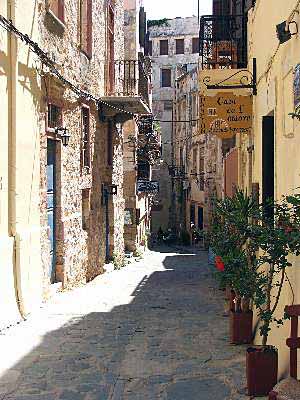 |
 |
 |
| The lovely port of Agios Nikolaos connects to Lake Voulismeni, and the resort town surrounds the lake. According to legend, Artemis and Athena bathed at the lake. According to inscriptions dating to 193 BC, the town was one of two Hellenistic cities called Lato (one, Lato pros Kamara or "towards the arch" and the other, Lato Etera or "other Lato.") | |
| Near Agios Nikolaos stands Spinalonga Island. The fortress that takes up most of its space was built by the Venetians in the sixteenth century and was in use as a leper colony as late as the 1950s. It turned out that leprosy wasn't all that contagious after all. | |
| This thirteenth-century Venetian lighthouse welcomes visitors to Rethymnon, Crete's third-largest city. The rest of the town's Venetian fortifications, called the Fortessa, was built by forced labor from the town and surrounding villages from 1573 to 1583. It survived a siege by the Turks for only three weeks before Rethymnon surrendered. | |
| Chania, near the western end of Crete, was an
important late Minoan center. Historians know this based on the amount and
quality of pottery and clay coffins discovered in the area. Unfortunately,
no palace has yet been found for potential excavation. After the Minoan
civilization ended, the city was ruled by the Romans, Byzantines, Venetians,
Genoese, Turks, and even the Egyptians. Chania was the capital of Crete from
1841 until 1971.
The Venetians left their mark in the old town, though, with the many neo-Classical mansions that now line the narrow streets. In this reincarnation, the buildings house small hotels and restaurants and shops.
|
 |
 |
Scholars believe that the earliest poetry was sung or
chanted, and both music and dance are an integral part of Greek and Cretan
culture. During the summer, folk festivals all over the country celebrate
the music and the many regional dances and colorful costumes associated with
rural Greece. The dances celebrated everyday life, like harvest, war, mourning, and religion. You'll see the leader performing intricate steps that take him to his knees and return to his feet with the simple support of a handkerchief held by another dancer in the circle. Music includes the mandolin-like bouzouki and in Crete, the lyre, played using a bow (and supposedly invented by Hermes of a turtle shell and presented as a gift of atonement to Apollo.) You can see a short movie of the lyre and bouzouki by clicking here (it will open in a new window.) |